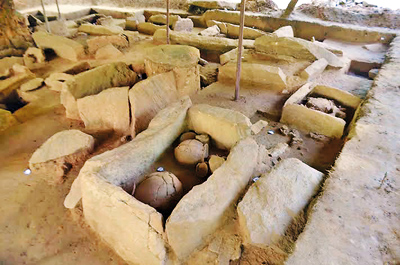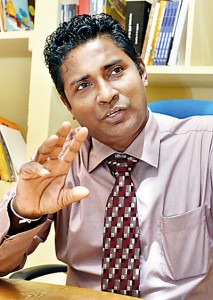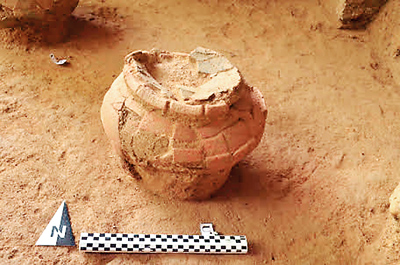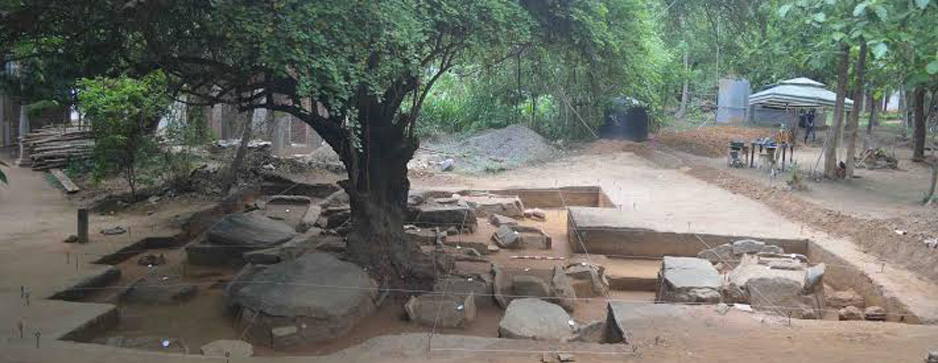Hidden history rises from the ashes
A peek into clay urns, large and small, unearthed in Ibbankatuwa, a stone’s throw from the World Heritage Site of the Dambulla cave temple, will give Sri Lankans a glimpse into the distant past, as far back as any time between 1,000 to 300 years BC.

Cist-burials galore at Ibbankatuwa and below an urn burial. Pix courtesy of the Central Cultural Fund
Agog with excitement and expectation, a team from the Central Cultural Fund (CCF) under the expert guidance of Director-General, Prof. Prishanta Gunawardhana, is gingerly carrying more than 40 urns from the latest dig in Ibbankatuwa to the CCF laboratory in Dambulla.
Ibbankatuwa was unearthed as an archaelogical site, believed to hold burials in the 1970s, with associated rites and rituals covered by the dim mists of time.
With the Mahawamsa placing the arrival of Vijaya and his band of men about the 6th century BC, the latest finds at Ibbankatuwa, may even cast some light on burial practices even before that, in times when the inhabitants of the area had moved from hunting and gathering to early agricultural practices, it is learnt.
| Burial rites from the distant pastRevealing its secrets, the Ibbankatuwa ‘cemetery’ unveils two types of burials – the cist-type (box-shaped burial chamber) and the urn type.While cist-burials may have been the order of the day, for some reason, may be the lack of material, the people of those times had also resorted to urn burials, says Prof. Gunawardhana.In cist-burials, after the cremation of the dead person they had placed the ash in a pit surrounded by four stone-slabs covered with another stone-slab. However, in urn burials, the ash had been placed in an urn, with the spot being marked by just one stone slab. Along with the dead person’s ashes, had been placed whatever body ornaments he/she wore such as beads and bangles and also pottery the person may have used, says Prof. Gunawardhana. So far the team has unearthed 25 cist-burials and 15 large urns with smaller stone slabs marking the area of placement. |
“Soon, very soon, we will look into the urns and take samples to check out what is in them as well as to date them,” said Prof. Gunawardhana, himself going down memory lane to a guru-gola (teacher-student) visitation of the Ibbankatuwa site.
Most probably with villagers or archaeological surveys indicating that the area was rich with artefacts, it had been then Archaeological Commissioner Dr. Raja De Silva who had in the 1970s excavated a small cluster at Ibbankatuwa, located just 2km from the Dambulla temple, unearthing some pottery.

Prof. Prishanta Gunawardhana
Much later, between 1988 and 1992, Prof. Senake Bandaranayake had re-visited the site along with a German team, when he was Director of the CCF under which came both Sigiriya and Dambulla, as well as Director of the Post-graduate Institute of Archaeology (PGIAR).
The dig covered a 10X10 metre area and brought forth not only pottery but also a decaying but visible wooden cremation platform. Strewn around were other materials too such as carnelian glass beads and terra cotta bangles.
“The pottery was black and red ware indicating advanced technology and the stone formation was identified as that of cist-burials.
This was the turning point and brought the site into major public focus,” says Prof. Gunawardhana who was then a golaya of Prof. Bandaranayake and trailed behind him to Ibbankatuwa.
Prof. Bandaranayake subjected the charcoal found in the soil at the site to carbon dating (using a radioactive isotope of carbon to determine the age of organic material) which placed it in the 650 BC period.
But the site seemingly being a bare land, people settled in the area, with such settlements intensifying four years ago. What the local authorities did not realize was that about a 20-acre area was replete with underground artefacts even though above-ground one could only see single gal-para (stone slabs) except for the cist-grave site, laments Prof. Gunawardhana, adding that the gal-para distribution seemed to have misled them about the archaeological value of the area.
Soon after taking over as CCF Director-General, he requested the Archaeological Department under which came Ibbankatuwa to let the CCF take-over. Getting the site two months ago, the CCF dig began in earnest a month ago, on another 10X10 metre site adjoining the one excavated by Prof. Bandaranayake. Of immense support in the excavations are PGIAR Senior Lecturer Dr. Ranjith Bandara and CCF Project Manager Ajith Jayasundera who are working with 15 graduates from various universities and 10 assistants drawn from the village.

Dr. Bandara was not contactable for a comment as he was at the site.
The factors that made the current CCF Director-General seek the Ibbankatuwa site are three-pronged.
“It is an important archaeological site, there is a need to sensitively manage the people already settled in the area and it would be a good tourism promotion site,” he says.
Meticulously and carefully collecting samples of charcoal from the soil for carbon-dating and sand for OSL (optically stimulated luminescence) testing, the CCF is hoping to re-examine the dating done in the 1980s.
While they also look into the urns and pots and collect more samples to be sent for testing in India and the United Kingdom which have the technology to do so, the CCF has big plans for Ibbankatuwa.
With tourists already flocking to the area having heard by word of mouth about the finds, Prof. Gunawardhana’s vision for Ibbankatuwa is a Burial Museum with all the artefacts unearthed from there, alongside the burial site.
A walk around the museum would give an insight into the rituals and rites, followed by a glimpse of the graves themselves.

Where the dig is taking place at Ibbankatuwa


